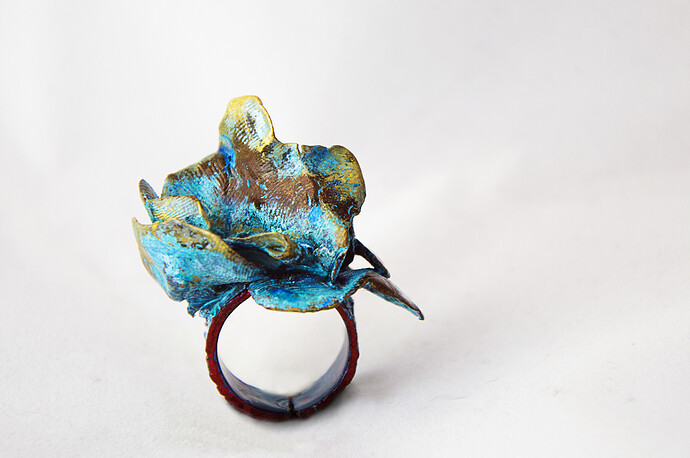Materials: brass
Dimensions: 6x4cm
Ring collection "Underwater lights". It is a series of accessories made of brass by casting technique. The brass is oxidized with different chemicals for create different colors. Oxides are neutralized and then lacquered. Inside the ring there are colored enamel.
Myriam M Moreno Martinez
myriammoreno.com
Lliria, Valencia. Spain
She was born on September 20th, 1990 in Valencia.She grows in Liria, but spent his early years traveling around Europe with her parents. In 2004, she enrolled at the Academy Weronika Zerdzinska-Pawlak, which will recognize the painting as a choice for the future. In 2006 starts the Arts Bachelor in IES Camp del Turia, Liria. During these formative years makes some specialized courses with Beatriz Ferrer Carbonell in the Arctu-keltoi academia. Association through which she traveled to diferent countries such as Italy and Cyprus, participating in group activities within the Youth in Action program of the EU.
In 2008 she enrolled at the Faculty of Fine Arts of San Carlos in the UPV. At the same time she attended several courses as experimental video, window dressing, creative printing, book binding applied to artist book or management and exhibition design. Make in 2010 her first solo exhibition "The Nothing, the Infinite". In 2011 her second solo exhibition "Walls" in the Hall / Youth Center Campoamor, her work was accepted by the City Council committee. And in 2012 her third solo exhibition "Soft" in the Sala Dinámica Hall, her work then begins to display a very sensitive and personal style. That same year the she is awarded with a scholarship PROMOE UPV at the China Central Academy of Fine Arts, where she finished her degree. Is invited to join United Artists group of Liria (AULL) and Space ART ROOM XXI project, driven by the Documentation Centre d'Art Contemporary Valencian "Rom? de la Calle" (CDAVC), which had an exhibition at the Museum Centre del Carme in Valencia as outcome.
Her work is presented in different manifestations such as performance, sculpture, installation, painting, collage... In her work the concept is as important as the holder,the materials used are of great significance, possess its own energy.. She use organic materials such as wood, bones, insects... Each element contributes a specific substance.
The exhibition explores metal works whose primary theme is color embraced as their primary visual focus, whether that be using colored materials, exploring creating colored surfaces, or encasing the object in color.
As the world's largest jewelry related internet site, Ganoksin strives to develop exhibitions showcasing work from around the world. This exhibition was open to all metalsmiths, professional and amateur, advanced and beginner.
In total 303 artists contributed 814 show pieces for the permanent online exhibition.
The exhibition was curated by Beth Wicker, President of the North Carolina Society of Goldsmiths in the United States, and Adjunct Instructor at Northeastern Technical College in South Carolina. Director of the exhibition is Hanuman Aspler, founder of The Ganoksin Project, the world's largest internet jewelry site.
Hue is one of the primary properties of color, it refers to the place the color occupies on the visual spectrum. Humans have used hues throughout time, to create cave paintings, to decorate themselves, their clothing and their housing.
Different hues have taken on different meanings throughout time. Gold traditionally has been a color of purity - the metal gold is relatively unchangeable, and the hue of gold has come to stand for gods and goddesses, for royalty, for durability and for purity. Red has often meant love, or passion. Hues often reflect the meaning of the seasons, with pastels referring to spring and the burst of new life after the pale hues of winter. Summer is reflected in vibrant, deep hues, followed by the browning of hues in the fall as plants go to seed and die, and the land turns fallow.
The worth of a hue has often been tied to what is necessary to make the pigment that creates the hue, and the expensive involved in the process. Often created from crushed stones that had to be mined and carried by caravan over thousands of miles, or from fermented roots of plants only grown in certain areas, or the carapaces of rare insects - the creation of hue in a way that could be used by man was an involved and generally expensive process.
In today's world metalsmiths have access to perhaps the widest range of materials and hues in the history of man - and in some of the most affordable ways ever.
This exhibition celebrates hue - color - as an integral, inherent element of the work. We talk of the "richness" of color, and examples of this abound here. One expects hues from the colors of gemstones used in metalsmithing, but we also have hues from some less expected places. Glass enamels are an ancient way of adding color, as are a variety of patinas. Today's artists also use synthetic man-made materials to add color in ways that didn't exist a century ago.
We invite you to enjoy this celebration of hue, and the ways hues and their use have changed over time.
